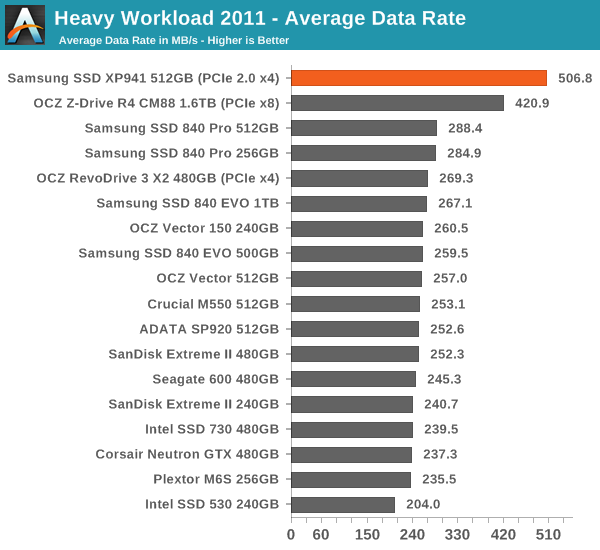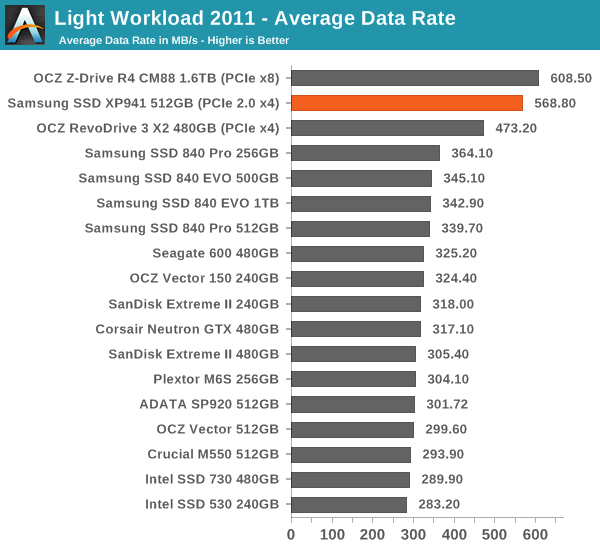Samsung SSD XP941 Review: The PCIe Era Is Here
by Kristian Vättö on May 15, 2014 12:00 PM ESTAnandTech Storage Bench 2011
Back in 2011 (which seems like so long ago now!), we introduced our AnandTech Storage Bench, a suite of benchmarks that took traces of real OS/application usage and played them back in a repeatable manner. The MOASB, officially called AnandTech Storage Bench 2011 - Heavy Workload, mainly focuses on peak IO performance and basic garbage collection routines. There is a lot of downloading and application installing that happens during the course of this test. Our thinking was that it's during application installs, file copies, downloading and multitasking with all of this that you can really notice performance differences between drives. The full description of the Heavy test can be found here, while the Light workload details are here.

The same goes for our 2011 Storage Bench: the XP941 is unbeatable. Only in the Light Workload test, the 8-controller OCZ behemoth is able to beat the XP941 by a small margin, but other than that there's nothing that can challenge the XP941. The consumer-oriented OCZ RevoDrive comes close but the XP941 once again shows how a good single controller design can beat any RAID 0 configuration.











110 Comments
View All Comments
RamCity - Monday, May 19, 2014 - link
The Lycom M.2 to PCie adapter does a reasonable job with small form factor computers. It has a low-height bracket in addition to the standard height one. Note though, you can't boot the XP941 in any windows PC with one of these adapters as far as we know - it wont show up in the bios as a bootable device. Only in a 2006-2012 Mac Pro under OSX will it be bootable.Rod
Oscarcharliezulu - Monday, May 19, 2014 - link
Nice job anandtech... You detected what country i was reading this from and inserted appropriate text/prices? Great job. Appreciated.kizh - Tuesday, May 20, 2014 - link
still running my sandy 2500k that did 4.8 reliably until I updated bios. I bought a z67 board that had a pcie 3.0 x 16 lane as an early adopter. The only thing worth upgrading on it was the graphics so bought a 780 (on accident thought it was a 780 ti) I spent about 24 hours of my time researching making it work on a early version of uefi and trying multiple set ups. Gonna send it back, its not worth upgrading my whole system for this.Never buying another feature that isn't being used yet, by the time its truly a standard your warranty is over and FU if it got tweaked a little.
Got 2 M2 in raid, no trim ever bothered me. Its fast enough, don't need this. Maybe if a whole system upgrade was as fun as it used to be,
Right now all I see waiting for is a 4k display port standard and some nicer models coming out. I want to throw money at these guys but not for next to nothing,
I'm not rich by any measure but dumped money on tech as a hobbyist.
kizh - Tuesday, May 20, 2014 - link
oh just to clarify I know it would only be pcie 3.0 with ivy, I didn't expect that chip to be such a let down. Still this should have worked at pcie 2.0. Also when I say m2 I'm talking about the model name of my ssd's. not m.2just some clarifications
sfgebrqy - Wednesday, May 21, 2014 - link
I would have bought this in a heart-beat if it weren't for two things:1) Average/bad 4k random read/write
2) Abysmal 4k scaling with QD
The killer feature for this SSD is without a doubt its sequential performance. Compared to any single SSD alone, it blows it out of the water on the benches, whether
practical or synthetic.
The caveat is "single SSD". RAID 0 can always be used to boost sequentials. Maybe not exactly linearly, but close to linearly. Take a look at the review for 2 Samsung 840
Pros in RAID 0 (page 3). I can't link (or even mention the website) it because the comment filter says its spam, so take a guess and use Google. Sequentials are nearly
doubled for both read and write.
The kicker is that this CANNOT be done for random I/O at low QD. Which is to say, if we wanted better random I/O from XP941s, we couldn't RAID them together to do it. In
fact, RAID typically makes random I/O marginally worse at low QD due to overhead. See the aforementioned review (page 4).
RAID does multiply random I/O at high QD, but with XP941 4k QD scaling non-existent to begin with, it's a lost cause.
Even if we did want to RAID XP941s together, I can't seem to find any tests/reviews of more than two at once, let alone a RAID controller capable of putting more than two
M.2 devices in RAID 0. Meanwhile, there are plenty of RAID controllers capable of pushing 16+ SATA3 devices (albeit bottlenecked at x8 PCIe 3.0).
The bottom line is that if I found out that my current SATA3 SSD RAID 0 array wasn't putting out enough sequential, I could just add a few more SSDs to solve the issue. If I
found out that my XP941 array wasn't putting out enough random I/O, there's nothing I could do to fix it.
If you're in the market for single SSDs and your system can handle M.2, then this is the cream of the crop. If you have RAID arrays though, wait until M.2 becomes more
popular and Samsung pushes a new M.2 SSD with better random I/O performance.
skrewler2 - Sunday, May 25, 2014 - link
Sorry late to the party but this part of the article is just ignorant:"Using an SSD as a secondary drive can make sense for e.g. a video professional where the performance can be utilized as a scratch disk, but otherwise the only real use case for an SSD is as a boot drive"
What the hell?
aviv - Wednesday, June 4, 2014 - link
Hey gr8 reviewI got question about the graphs
Its log systemic
Does it means when its lower by 1/10 its just half of the value or
In between its linar
brentpresley - Thursday, July 3, 2014 - link
ASUS just released a new BIOS today (7/3/2014) that allows for M.2 boot support of the XP941.I just installed it and the BIOS can see the XP941 in AHCI mode now.
iBurley - Wednesday, December 3, 2014 - link
If put into the M.2 slot of one of the ASRock Z97 boards mentioned in the review, will this be running at full speed, or would I need an adapter like you tested with to use the full potential of the drive?On ASRock's website, under the port listing for the board, it states "1 M.2 (PCIe Gen2 x2 & SATA, Supports 30mm, 42mm, 60mm, 80mm, 110mm M.2 devices)" but I don't know if that just means the interface or if it would actually go over the PCIe bus instead of SATA.
SERGE 2015 - Tuesday, July 14, 2015 - link
I have AsRock's Z97 Extreme6 and XP941 and it is unfortunately NOT bootable out of the box. As it's been mentioned - once the system boots up using another EFI source, the XP941 becomes visible and can then load whatever been installed on it. This is due to lack of OpROM on XP941. The new Samsung SM951 been declared as "Supports Standard AHCI driver" though.